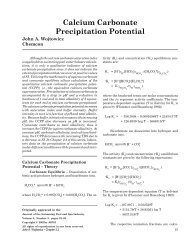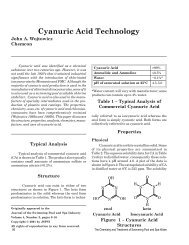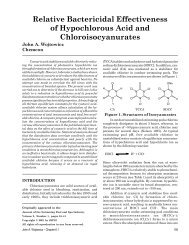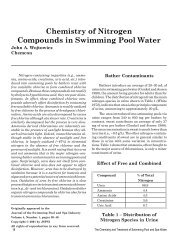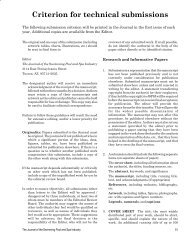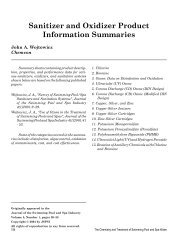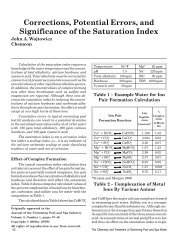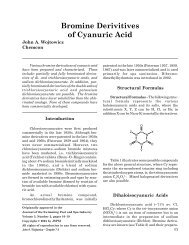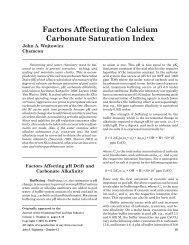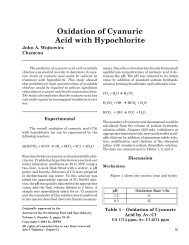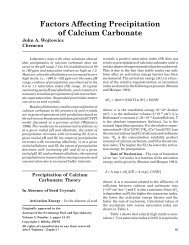Swimming Pool and Spa Water Chemical Adjustments - jspsi
Swimming Pool and Spa Water Chemical Adjustments - jspsi
Swimming Pool and Spa Water Chemical Adjustments - jspsi
You also want an ePaper? Increase the reach of your titles
YUMPU automatically turns print PDFs into web optimized ePapers that Google loves.
discussed earlier. The decrease in total alkalinity<br />
(∆TA) is calculable from the quantity of acid<br />
added.<br />
∆TA = (fl. oz acid)•29.57•d•p•1000•50/<br />
(EW•V•3.7854)<br />
where: d equals 1.16 for muriatic acid <strong>and</strong> 1.29 for<br />
sulfuric acid, p equals 0.3145 for muriatic acid<br />
<strong>and</strong> 0.385 for sulfuric acid, EW is equivalent<br />
weight – 36.46 for hydrochloric acid <strong>and</strong> 49.04 for<br />
sulfuric acid. The above calculation yields similar<br />
results (to within 1%) for each acid. Thus, one<br />
quart (i.e., 32 fl oz) of 31.45% muriatic acid <strong>and</strong><br />
38.5% sulfuric acid added to 10,000 gal of pool<br />
water reduces alkalinity by 12.5 <strong>and</strong> 12.7 ppm,<br />
respectively, as calculated by the following condensed<br />
formulas:<br />
∆TA = 3912.0•V MA /V<br />
∆TA = 3962.8•V SA /V<br />
where: V MA equals the volume (fl oz) of muriatic<br />
acid <strong>and</strong> V SA equals the volume (fl oz) of sulfuric<br />
acid.<br />
Decrease in Alkalinity after Sodium<br />
Bisulfate Addition – The change in total alkalinity<br />
when sodium bisulfate is used for pH adjustment<br />
is calculated as follows:<br />
∆TA = W BS •28.35•p•1000•50/(120•V•3.7854)<br />
= 3120.5•W BS •p/V<br />
where: W BS equals the weight (oz) of sodium<br />
bisulfate, 120 is the molecular weight of sodium<br />
bisulfate. Assuming a degree of purity of 0.95 (i.e.,<br />
95% purity), each pound (i.e., 16 oz) of sodium<br />
bisulfate added to 10,000 gal of pool water will<br />
reduce total alkalinity by 4.7 ppm.<br />
Increase In Alkalinity after Sodium Carbonate<br />
Addition – The increase in total alkalinity<br />
(∆TA) resulting from addition of sodium carbonate<br />
(soda ash) can be calculated using the<br />
following formula:<br />
∆TA = W SC •28.35•1000•50/(53•V•3.7854•p)<br />
= 7065.4•W SC /(V•p)<br />
where: W SC equals the weight (oz) of sodium<br />
carbonate, <strong>and</strong> 53 equals the equivalent weight of<br />
sodium carbonate. Assuming a typical degree of<br />
purity of 0.998 (i.e., 99.8% purity), each pound<br />
(i.e., 16 oz) of soda ash added to 10,000 gals of pool<br />
water will increase the total alkalinity by 11.3<br />
ppm.<br />
Alkalinity Adjustment<br />
All tap <strong>and</strong> well water contain varying<br />
amounts of alkalinity depending on the source. In<br />
new pools the alkalinity may require adjustment<br />
to the recommended range (see Table 1). In established<br />
pools, makeup water to replace evaporation<br />
losses will increase the pool or spa alkalinity.<br />
In addition, alkaline sanitizers will increase alkalinity<br />
to a small extent, whereas acidic sanitizers<br />
will decrease alkalinity to a significant<br />
extent (Wojtowicz 1995b). High alkalinity is lowered<br />
by acid addition whereas low alkalinity is<br />
increased with sodium bicarbonate.<br />
Increasing Alkalinity with Sodium Bicarbonate<br />
– Sodium bicarbonate is used to increase<br />
total alkalinity. Addition of sodium bicarbonate<br />
to pool water will increase the concentration<br />
of bicarbonate ions, which will repress ionization<br />
of carbonic acid resulting in a lower hydrogen<br />
ion concentration <strong>and</strong> a higher pH.<br />
H 2 CO 3<br />
– +<br />
HCO + H 3<br />
However, the effect is very small. For example,<br />
increasing the total alkalinity by 20 ppm with<br />
sodium bicarbonate in pool water at 80°F, pH 7.5,<br />
total alkalinity 80 ppm, cyanuric acid 100 ppm,<br />
av. Cl 3 ppm, <strong>and</strong> TDS 1000 ppm will increase the<br />
pH to only 7.55.<br />
The quantity of sodium bicarbonate (W SB<br />
(lb)) can be calculated using the following equation:<br />
W SB = ∆TA•84•V•3.7854/(50•!000•453.6•p)<br />
= 1.40•10 – 5 •∆TA•V/p<br />
where: ∆TA equals the increase in total alkalinity<br />
(ppm), 84 equals the molecular weight of sodium<br />
bicarbonate, <strong>and</strong> p is typically 1.0, i.e., 100%<br />
assay. Tables are available showing dosages for<br />
various water volumes.<br />
196 The Chemistry <strong>and</strong> Treatment of <strong>Swimming</strong> <strong>Pool</strong> <strong>and</strong> <strong>Spa</strong> <strong>Water</strong>



